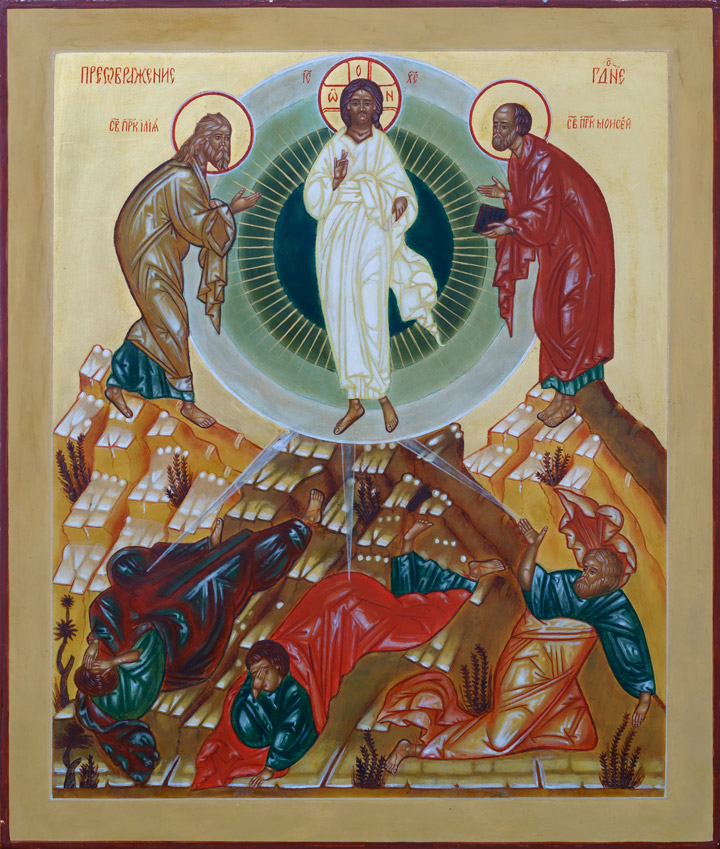
The Transfiguration of Christ
The Transfiguration of Christ is one of the Great Feasts of the Orthodox Church, celebrated on August 6 and August 19 (according to Old Calendarists), using the Gregorian Calendar, Julian Calendar, and Revised Julian Calendar.
Jesus had gone with his disciples Peter, James, and John to Mount Tabor. Christ's appearance was changed while they watched into a glorious radiant figure. There appeared Elijah and Moses, speaking with Jesus. The disciples were amazed and terribly afraid.
This event shows forth the divinity of Christ, so that the disciples would understand after his Ascension that He was truly the radiant splendor of the Father, and that his Passion was voluntary (Mark 9:2-9). It also shows the possibility of our own theosis.
This event was the subject of some debates between Gregory Palamas and Barlaam of Calabria. Barlaam believed that the light shining from Jesus was created light, while Gregory maintained the disciples were given grace to perceive the uncreated light of God. This supported Gregory's larger argument that although we cannot know God in His essence, we can know Him in his energies, as He reveals Himself.
Accounts of the Transfiguration are found in the Bible: Matthew 17:1-8, Mark 9:2-9, Luke 9:28-36, and II Peter 1:16-19.
Celebration of the feast
Like all feasts of the Master, the Transfiguration is a vigil-ranked feast, though in parish practice a full All-Night Vigil is usually not celebrated. Typically, Great Vespers is conducted on the eve of the feast, and on the morning of the feast, the Divine Liturgy of Saint John Chrysostom celebrated, traditionally preceded by the Matins service.
The Vespers service includes the readings: Exodus 24:12-18, 33:11-23, 34:4-6, 8; I Kings 19:3-9, 11-13, 15-16. The Matins service includes the reading: Luke 9:28-36. And the Divine Liturgy: II Peter 1:10-19; Matthew 17:1-9.
It is believed that Christ's transfiguration took place at the time of the Jewish Festival of Booths, and that the celebration of the event in the Christian Church became the New Testament fulfillment of the Old Testament feast. Presently it is celebrated on the sixth of August, forty days before the feast, Elevation of the Holy Cross. Just as Peter, James, and John saw the transfiguration before the crucifixion so that they might know who it is who will suffered for them, the Church connects these two feasts to help the faithful understand the mission of Christ and that his suffering was voluntary. The feast of the Transfiguration of Christ once belonged to the season of Great Lent, but may have been considered too joyous for that time. Saint Gregory Palamas, a great teacher of the Transfiguration, is now celebrated on one of the Sundays of Lent instead.
Traditions
In Greece and Romania the harvest season traditionally began on the Transfiguration. Grapes, in particular, were not eaten before August 6. In some parishes, the first grapes would be brought to church for a blessing and distributed to parishioners.
Hymns
Troparion (Tone 7)
You were Transfigured on the Mount, O Christ God, Revealing Your glory to Your disciples as far as they could bear it. Let Your everlasting Light shine upon us sinners! Through the prayers of the Theotokos, O Giver of Light, glory to You!
Kontakion (Tone 7)
On the Mountain You were Transfigured, O Christ God, And Your disciples beheld Your glory as far as they could see it; So that when they would behold You crucified, They would understand that Your suffering was voluntary, And would proclaim to the world, That You are truly the Radiance of the Father!